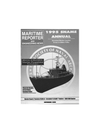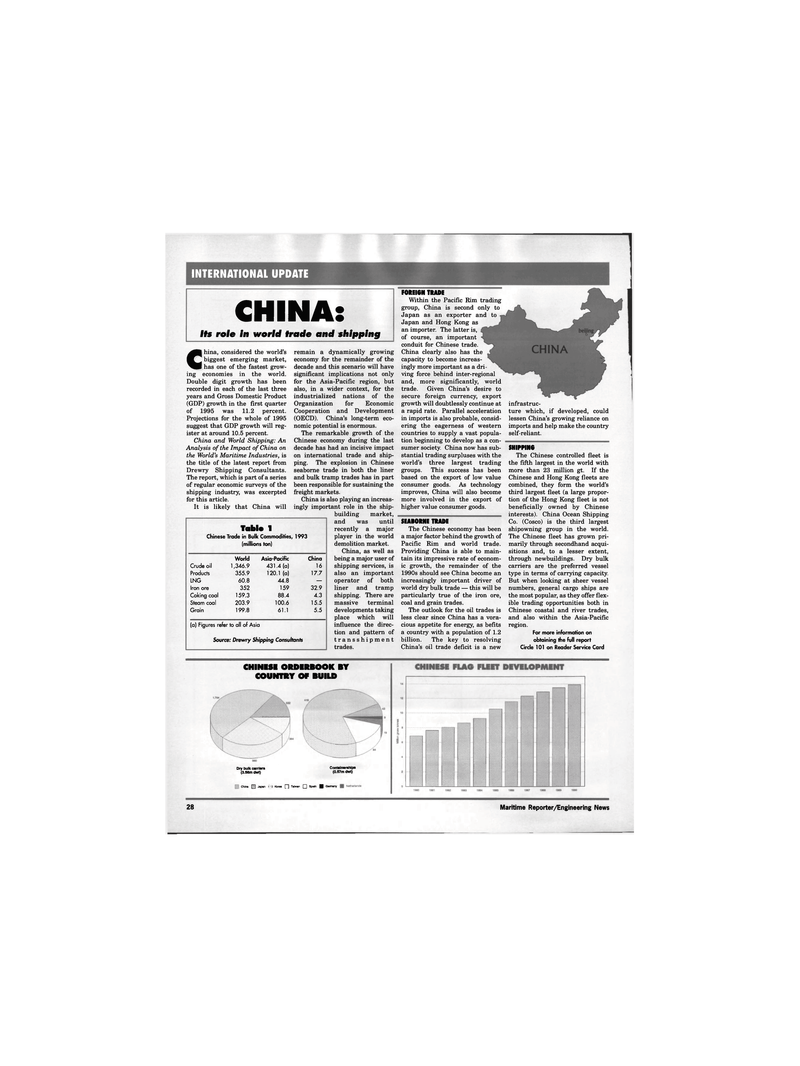
Page 26: of Maritime Reporter Magazine (September 1995)
Read this page in Pdf, Flash or Html5 edition of September 1995 Maritime Reporter Magazine
INTERNATIONAL UPDATE
CHINA:
Its role in world trade and shipping
China, considered the world's biggest emerging market, has one of the fastest grow- ing economies in the world.
Double digit growth has been recorded in each of the last three years and Gross Domestic Product (GDP) growth in the first quarter of 1995 was 11.2 percent.
Projections for the whole of 1995 suggest that GDP growth will reg- ister at around 10.5 percent.
China and World Shipping: An
Analysis of the Impact of China on the World's Maritime Industries, is the title of the latest report from
Drewry Shipping Consultants.
The report, which is part of a series of regular economic surveys of the shipping industry, was excerpted for this article.
It is likely that China will
Table 1
Chinese Trade in Bulk Commodities, 1993 (millions ton)
World Asia-Pacific China
Crude oil 1,346.9 431.4 (a) 16
Products 355.9 120.1 (a) 17.7
LNG 60.8 44.8 —
Iron ore 352 159 32 9
Coking coal 159.3 88.4 4.3
Steam coal 203.9 100.6 15.5
Grain 199.8 61.1 5.5 (a) Figures refer to all of Asia
Source: Drewry Shipping Consultants remain a dynamically growing economy for the remainder of the decade and this scenario will have significant implications not only for the Asia-Pacific region, but also, in a wider context, for the industrialized nations of the
Organization for Economic
Cooperation and Development (OECD). China's long-term eco- nomic potential is enormous.
The remarkable growth of the
Chinese economy during the last decade has had an incisive impact on international trade and ship- ping. The explosion in Chinese seaborne trade in both the liner and bulk tramp trades has in part been responsible for sustaining the freight markets.
China is also playing an increas- ingly important role in the ship- building market, and was until recently a major player in the world demolition market.
China, as well as being a major user of shipping services, is also an important operator of both liner and tramp shipping. There are massive terminal developments taking place which will influence the direc- tion and pattern of transshipment trades.
FOREIGN TRADE
Within the Pacific Rim trading group, China is second only to
Japan as an exporter and to
Japan and Hong Kong as an importer. The latter is, of course, an important conduit for Chinese trade.
China clearly also has the capacity to become increas- ingly more important as a dri ving force behind inter-regional and, more significantly, world trade. Given China's desire to secure foreign currency, export growth will doubtlessly continue at a rapid rate. Parallel acceleration in imports is also probable, consid- ering the eagerness of western countries to supply a vast popula- tion beginning to develop as a con- sumer society. China now has sub- stantial trading surpluses with the world's three largest trading groups. This success has been based on the export of low value consumer goods. As technology improves, China will also become more involved in the export of higher value consumer goods.
SEABORNE TRADE
The Chinese economy has been a major factor behind the growth of
Pacific Rim and world trade.
Providing China is able to main- tain its impressive rate of econom- ic growth, the remainder of the 1990s should see China become an increasingly important driver of world dry bulk trade — this will be particularly true of the iron ore, coal and grain trades.
The outlook for the oil trades is less clear since China has a vora- cious appetite for energy, as befits a country with a population of 1.2 billion. The key to resolving
China's oil trade deficit is a new infrastruc- ture which, if developed, could lessen China's growing reliance on imports and help make the country self-reliant.
SHIPPING
The Chinese controlled fleet is the fifth largest in the world with more than 23 million gt. If the
Chinese and Hong Kong fleets are combined, they form the world's third largest fleet (a large propor- tion of the Hong Kong fleet is not beneficially owned by Chinese interests). China Ocean Shipping
Co. (Cosco) is the third largest shipowning group in the world.
The Chinese fleet has grown pri- marily through secondhand acqui- sitions and, to a lesser extent, through newbuildings. Dry bulk carriers are the preferred vessel type in terms of carrying capacity.
But when looking at sheer vessel numbers, general cargo ships are the most popular, as they offer flex- ible trading opportunities both in
Chinese coastal and river trades, and also within the Asia-Pacific region.
For more information on obtaining the full report
Circle 101 on Reader Service Card
CHINESE ORDERBOOK BY
COUNTRY OF BUILD
China @ Japan KbrBa [~] Taiwan Q Spain f|] Germany
Dry bulk carriers (3.56m dwt)
Containerships (0.57m dwt) 28 Maritime Reporter/Engineering News

 25
25

 27
27
